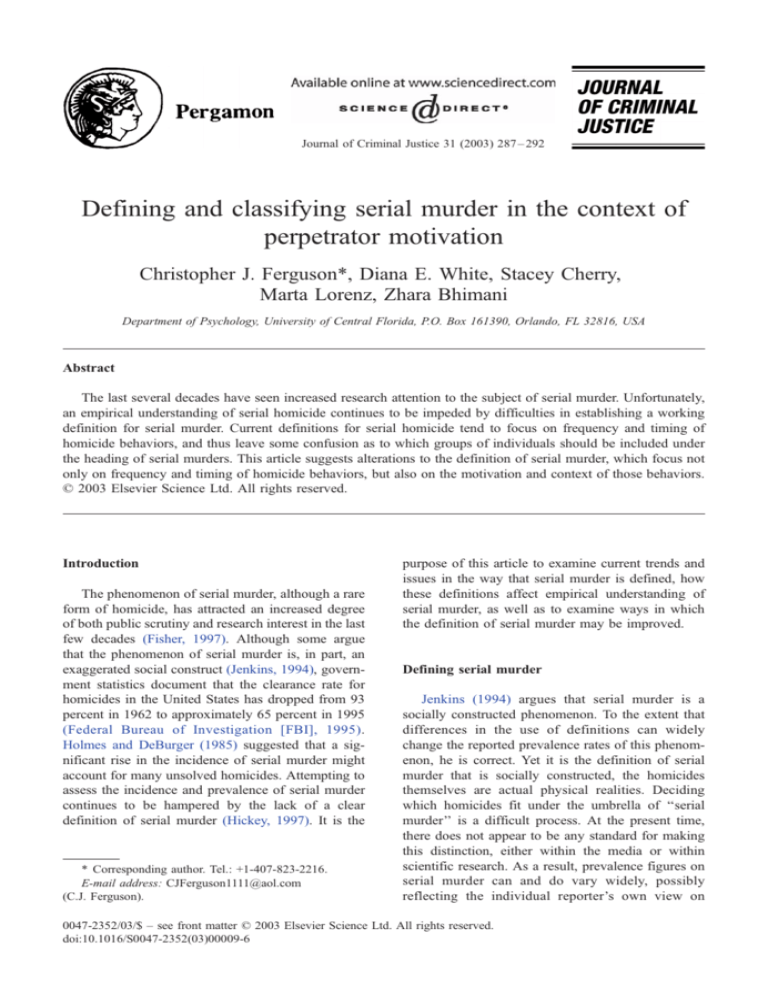
Journal of Criminal Justice 31 (2003) 287 – 292
Defining and classifying serial murder in the context of
perpetrator motivation
Christopher J. Ferguson*, Diana E. White, Stacey Cherry,
Marta Lorenz, Zhara Bhimani
Department of Psychology, University of Central Florida, P.O. Box 161390, Orlando, FL 32816, USA
Abstract
The last several decades have seen increased research attention to the subject of serial murder. Unfortunately,
an empirical understanding of serial homicide continues to be impeded by difficulties in establishing a working
definition for serial murder. Current definitions for serial homicide tend to focus on frequency and timing of
homicide behaviors, and thus leave some confusion as to which groups of individuals should be included under
the heading of serial murders. This article suggests alterations to the definition of serial murder, which focus not
only on frequency and timing of homicide behaviors, but also on the motivation and context of those behaviors.
D 2003 Elsevier Science Ltd. All rights reserved.
Introduction
The phenomenon of serial murder, although a rare
form of homicide, has attracted an increased degree
of both public scrutiny and research interest in the last
few decades (Fisher, 1997). Although some argue
that the phenomenon of serial murder is, in part, an
exaggerated social construct (Jenkins, 1994), government statistics document that the clearance rate for
homicides in the United States has dropped from 93
percent in 1962 to approximately 65 percent in 1995
(Federal Bureau of Investigation [FBI], 1995).
Holmes and DeBurger (1985) suggested that a significant rise in the incidence of serial murder might
account for many unsolved homicides. Attempting to
assess the incidence and prevalence of serial murder
continues to be hampered by the lack of a clear
definition of serial murder (Hickey, 1997). It is the
* Corresponding author. Tel.: +1-407-823-2216.
E-mail address: CJFerguson1111@aol.com
(C.J. Ferguson).
purpose of this article to examine current trends and
issues in the way that serial murder is defined, how
these definitions affect empirical understanding of
serial murder, as well as to examine ways in which
the definition of serial murder may be improved.
Defining serial murder
Jenkins (1994) argues that serial murder is a
socially constructed phenomenon. To the extent that
differences in the use of definitions can widely
change the reported prevalence rates of this phenomenon, he is correct. Yet it is the definition of serial
murder that is socially constructed, the homicides
themselves are actual physical realities. Deciding
which homicides fit under the umbrella of ‘‘serial
murder’’ is a difficult process. At the present time,
there does not appear to be any standard for making
this distinction, either within the media or within
scientific research. As a result, prevalence figures on
serial murder can and do vary widely, possibly
reflecting the individual reporter’s own view on
0047-2352/03/$ – see front matter D 2003 Elsevier Science Ltd. All rights reserved.
doi:10.1016/S0047-2352(03)00009-6
288
C.J. Ferguson et al. / Journal of Criminal Justice 31 (2003) 287–292
whether serial murder is common or uncommon
rather than any objective reality. Establishing a set
definition of serial murder that demonstrates reliability would be a first step in standardizing the reporting
of prevalence statistics, as well as educating both
criminal justice professionals and the public on
exactly what is meant by ‘‘serial murder.’’ At such
point, though a definition of serial murder may still
arguably be socially constructed, at least it would be
one definition and not many separate definitions used
interchangeably. Before examining possible components to a definition of serial murder, this article will
concern itself with a discussion of those definitions of
serial murder in current use.
In the Crime Classification Manual, Douglas,
Burgess, Burgess, and Ressler (1992) define serial
homicide as ‘‘three or more separate events in three or
more separate locations with an emotional cooling off
period in between homicides’’ (p. 21). The emotional
cooling off period may last days, weeks, months, or
years. This definition discusses the time frame in
which the homicides occur, which distinguishes serial
murder from other forms of multiple murder such as
mass or spree murder. Though the specific number of
victims specified by the definition may vary, the basis
of this definition is generally common to most
definitions of serial murder (e.g., Egger, 1984;
Hickey, 1997; Holmes & Holmes, 1998b). The Crime
Classification Manual, which arguably forms the
basis of the FBI’s understanding of serial murder,
does not include motive specifically in the definition
of serial murder. In a book intended for a nonresearch
audience, however, the first author of the Crime
Classification Manual states that ‘‘Along with manipulation, domination and control, a significant motivator for almost all serial killing is sexual, even if, as
with Son of Sam David Berkowitz, the crimes themselves are not overtly so’’ (Douglas & Olshaker,
1999, p. 238). Blanchard (1995) agrees with this
assessment stating that, ‘‘Male serial killers almost
universally include a sexual assault as an integral part
of their ritualized murder patterns’’ (p. 62). This
linkage of serial murder with male perpetrated sexual
homicide arguably forms the implicit basis for the
FBI’s understanding of serial murder. Unfortunately,
this may result in a form of both empirical myopia, as
well as investigative blockage, as serial homicides
that do not fit the stereotype are discounted. For
instance, Douglas and Olshaker (1999) suggest that
Aileen Wournous is the only known female serial
killer in the United States. Even were serial murder to
be defined as sexual homicide, the authors seem to
ignore cases such as Gwendolyn Graham, Catherine
May Wood, Judith Neely, Carol Bundy, Karla Homolka, and others who participated in serial sexual
homicides. Curiously, the authors themselves
acknowledge some of these cases in their discussions,
yet discount them as serial murderers. Moreover, if a
sexual motive is not required for serial homicide, the
number of female serial murderers increases significantly, accounting for 10 – 15 percent of known serial
murderers (Holmes, Hickey, & Holmes, 1998). This
is an important point to note, as female suspects may
be ignored in cases of serial murder if the perpetrator
is assumed to be male and acting out of sexual desire.
Analyses such as those of Douglas et al. seem to
tacitly (though perhaps unreliably) include male serial
murderers without sexual motives, while ignoring
females with similar circumstances. At the same time,
it should be noted that analyses of serial murder that
utilizes definitions that are not dependent on sexual
motive would likely increase the total number of male
serial murderers identified, as well as female.
Egger (1984) provides a detailed definition of
serial murder which focuses not only on the number
and spacing of victims, but also on the role of fantasy
in the act of serial murder. According to Egger, serial
murderers spend a great deal of time fantasizing and
preparing for their eventual crime. The act of serial
murder then fulfills some intrinsic internal need and
is not primarily for financial gain or other pragmatic
ends. Although the fantasy element to Egger’s definition does not explicitly demand that the fantasies
be of a sexual nature, this appears to be the implicit
understanding. Arguably, an individual may have
homicide fantasies which revolve around power, nonsexual torture or even religious themes, yet the
‘‘fantasy’’ element of Egger’s definition fits most
neatly with a sexual theme. Egger, then, may be
similar in his views regarding serial murder as Douglas and Olshaker (1999) and the FBI. Some serial
murderers who do not meet this sexual homicide
stereotype, such as David Berkowitz or the Zodiac
Killer, are rationalized with notions of symbolic
sexual expression or the possibility that the perpetrator may masturbate at a later time while fantasizing
about the murders he has committed.
Hickey (1997) finds Egger’s definition of serial
murder to be too restrictive and too focused on
implied sexual elements. In particular, Hickey notes
that law enforcement definitions of serial murder may
ignore forms of serial murder other than sexual
homicide. For example, female or male medical
employees who engage in power-motivated murder
of patients, as well as individuals who systematically
murder their family members for financial or personal
gain would be ignored by this definition, even though
such individuals murder serially. Hickey argues that a
working definition of serial murder should be as
broad as possible. Specifically, Hickey argues that
serial murder should be defined as ‘‘all offenders who
through premeditation killed three or more victims
C.J. Ferguson et al. / Journal of Criminal Justice 31 (2003) 287–292
over a period of days, weeks, months or years. . .’’
(p. 12). Hickey notes that definitions of serial murder
which exclude financial motives, victims who are not
strangers, or female perpetrators are based on speculation rather than on any empirical foundation. Hickeys’ definition of serial murder and particularly his
inclusion of nonsexual motives for serial murder
represents a significant advance over definitions that
rely on male perpetrated sexual homicide. In particular, this definition sets a standard of consistency that
is set apart from the FBI’s often contradictory understanding of serial murder. At the same time, Hickey’s
definition may actually be too broad.
Using Hickey’s (1997) definition of serial murder,
a wide range of individuals may now be included
with widely disparate motives. In addition to males
and females who are motivated to engage in serial
murder for pleasure, individuals such as terrorists,
assassins, and armed robbers who kill multiple victims over time would be potentially classified as
serial murderers. While Hickey makes the case that
all such individuals share behavioral similarities, it
may be argued that this definition is too broad to be
empirically meaningful. For example, though a male
who murders for sexual pleasure may have distinct
behavioral patterns from a female who murders
hospital patients for the sense of power that it gives
her, these two individuals have some commonalities,
namely, that for both, the murder itself is the primary
motivating act. By contrast, an armed robber who
kills may be motivated primarily by financial gain,
and could arguably be distinct from the first two
individuals. Thus, a definition which is too general
and focuses primarily on temporality and broad
classes of behavior may result in including individuals into one category who are fundamentally different
from each other.
Keeney and Heide (1994) provide a slightly
different definition of serial murder. They suggest
that serial murder is ‘‘the premeditated murder of
three or more victims committed over time, in separate incidents, in a civilian context, with the murder
activity being chosen by the offender’’ (p. 384). The
primary difference between this definition and that of
Hickey (1997) is regarding the civilian nature of the
homicides. Although this was meant to rule out cases
of multiple killings in the context of military engagements, as well as political assassinations, and thus
represents an improvement, it still presents some
ambiguities. It is unclear that killings committed as
an act of war would likely have been included under
the heading of serial murder by any researcher.
Similarly, it is not clear why political assassins would
be excluded, while organized crime assassins would
remain under the heading of serial murder. Further,
although it was not likely the authors’ intentions, this
289
definition may imply to some that any act of multiple
killings occurring on a military base would not be
included under the heading of serial murder. Yet a
soldier who systematically killed several of his or her
own comrades, or prisoners of war could reasonably
be labeled a serial murderer.
Each of these studies presented a valiant attempt
to operationally define serial murder, and the deficiencies of each approach detailed the difficulties of
attaining a definition which was both reasonably
inclusive of all serial murderers, yet capable of
discriminating between serial murderers and other
groups of homicide perpetrators.
Power and serial murder
While some researchers (e.g., Hickey, 1997) assert
that serial murderers are by and large acting out of a
need to reassert themselves against a society in which
they feel powerless, it is not necessarily true that all
serial murderers are motivated by a need to reduce
negative affect. Suggestions that serial murderers are
psychologically maladjusted may stem from several
sources. The first of these is an arguably natural
inclination for researchers and lay people alike to
assume that individuals who are capable of such
highly deviant and violent behaviors must themselves
be psychologically disturbed. Fox and Levin (1999),
however, note that serial murderers may neither be
mentally deranged nor products of an abusive childhood. Thus, serial murders may be psychologically
functional. Further, if psychological disturbance is
noted in serial murderers who are apprehended, this
may be because their psychological disturbance is the
cause of their apprehension, rather than their pattern
of homicides. Thus, apprehended serial murderers
represent an essentially self-selecting sample who
are not representative of serial murderers as a group.
Rather than serial murder being a deviant coping
mechanism for stress or a poor childhood, with some
individuals serial murder may function as a source of
pleasure by obtaining gratuitous power over individuals the perpetrator views as less than human. Thus,
serial murderer phenomenon may not have root in
psychopathology (or at least not mental illness), but
rather in a system for obtaining pleasure that focuses
on violence toward others who the perpetrator has
dehumanized. Serial murder, then, may be a source of
pleasure that is similar to hunting or fishing for other
individuals, only with the ‘‘catch’’ being human
rather than a nonhuman animal. A number of serial
murderers, including Karla Homolka, Ted Bundy,
Wayne Williams, David Berkowitz, and others have
neither any clear history of psychological disturbance
nor childhood which involved physical or sexual
290
C.J. Ferguson et al. / Journal of Criminal Justice 31 (2003) 287–292
abuse. An examination of Ted Bundy’s childhood, for
instance, revealed that the most unusual component
of his upbringing was his relationships with his
family. Bundy’s mother gave birth to him while she
was still quite young, and for many years she pretended to be his sister, while his grandparents took on
the parental role. Only during young adulthood (age
23) did Bundy discover the truth of his family
background (Holmes & Holmes, 1998a). While this
circumstance was certainly unusual, and made some
researchers quick to form hypotheses about how this
situation might have affected Bundy, it should be
added that this unusual family situation was identical
to one experienced by the guitarist, Eric Clapton
(Clapton & Roberty, 1995), and likely many other
individuals.
Aspects of motive in serial murder
While Douglas and Olshaker (1999) define serial
murder explicitly in terms of sexual motivation,
Hickey (1997) avoids discussion of motive altogether. From Douglas and Olshaker, one can observe
a potential warning regarding the inclusion of motive
into a definition of serial murder. Motive is often
difficult to discern, and there is a risk that researchers or investigators may project motives onto a
murder that may be inaccurate. Yet without the
inclusion of motive in the definition of serial murder,
research may be unable to be focused onto a distinct
group of individuals. It should be recognized that
attempts to find clearly delineated boundaries for a
definition of serial murder for which there is no
‘‘gray space’’ are unlikely to be successful. In
particular, attempting to include motive into a definition of serial murder will often result in some
degree of subjectivity on the part of the researcher.
For instance, if ‘‘power’’ was included as a motive
for serial murder but ‘‘financial gain’’ was not
included within the definition of serial murder, where
would a woman who systematically murdered several husbands for the insurance money fall? In this
case, clear financial incentives are one motive of the
perpetrator’s behavior. Yet, on a more subjective
level, it could be argued that the perpetrator is also
acting out of a sense of power. One potential
problem with including ‘‘power’’ as a motive for
serial murder is that it is possible to argue almost any
criminal is acting out of a desire to express power.
As such, specific motives shall be avoided in
attempting to construct a motive-based definition of
serial murder.
In an attempt to recognize serial murderers as a
distinct class of individuals divergent from other
types of criminals, it is suggested that a definition
of serial murder should include the following elements:
(1) Three or more victims killed during multiple and
discrete events.
(2) Causing death to the victim, at the time of the
killing, was considered to be pleasurable, stress
relieving, or otherwise consistent with the perpetrator’s internal set of values. The attacks
themselves did not fulfill only functional purposes.
(3) The murders did not occur under the discretion or
blessing of any political or criminal organization.
The first element to this definition, namely, that
three or more victims are killed during multiple and
discrete events with a significant cooling off period in
between, bears much resemblance to those of Douglas et al. (1992) and Hickey (1997). This portion of
the definition is intended to distinguish serial murder
from other types of murder, particularly mass murder
and spree murder. In cases of serial murder, each
event should essentially be unrelated to each other
event. For example, if a murderer were to kill a
witness to a prior murder, these two murders would
be considered to be linked, and nondiscrete from each
other. By contrast, a woman who kills her husband
with poison, and years later similarly kills one of her
children, then a second child still years after that
would be considered to be conducting discrete murder, even though all of the victims are biologically
related. Discrete homicides, then, imply that the
motive for each homicide is autonomous from that
of each other homicide. That does not mean that the
motive for each homicide cannot be identical in each
case, but rather, that one homicide does not generate
the motive for the next homicide. Discrete homicides
may still be linked by police organizations due to
similarities in modus operandi or in signature,
although it should not be assumed that all serial
murderers have clear signature elements to their
crimes.
The second element of this definition of serial
murder is that causing death to the victims, at the time
of the killings, was considered to be pleasurable,
stress relieving, or otherwise consistent with the
perpetrator’s internal set of values. This is to distinguish the motive for killing from those that may be
limited to rage, crimes of passion, or hatred or that
may be limited to functional, emotionally neutral
homicides. While serial murderers may feel a sense
of hatred or rage toward their victims, this form of
hatred may, in and of itself, be pleasure inducing. In
other words, the perpetrator enjoys or feels justified
in hating his or her victims. Thus, the act of murder,
though motivated by hatred, is still pleasurable. As an
C.J. Ferguson et al. / Journal of Criminal Justice 31 (2003) 287–292
example, a man who believes that prostitutes are dirty
or immoral and sets out to rid the world of them in the
name of God would be acting out of a sense of
justified hatred, and thus would find the homicides
pleasurable, or at least consistent with his value
system. By contrast, a man who murders his wife
because he has discovered she is having an affair
would also be acting out of hatred or rage. Yet in such
a case, the perpetrator may often experience his
emotions as a negative event, resulting in either
distancing oneself from the crime or shifting blame
for the crime onto the victim (Felson & Ribner,
1981). Unfortunately, little empirical analysis of levels of guilt in convicted murderers has been conducted, though a report by Ihalainen (1989) suggested
that convicted murderers suffered more sleep disturbances and nightmares which the author attributed to
feelings of guilt. If Ihalainen was correct, the perpetrator would feel himself (or herself) to be in pain, and
the murder itself would be out of step with his value
system, or displeasing. This is not to suggest that
serial murderers never feel negative emotions, such as
guilt or depression, related to their homicides, but
these emotions likely come after the commission of
the homicide, not during the homicide itself. Further,
the perpetrator is able to overcome any negative
emotions and continue to perpetrate further homicides in order to obtain repeated pleasure. Functional
homicides, in which the perpetrator commits murder
in order to reach a secondary goal such as an armed
robbery, would be considered to be motivated by
concerns other than pure emotional gratification and
thus not pleasurable. As such, an armed robber who
tends to panic during the robberies and kills several
people would not be considered a serial murder if he
was motivated only by attaining financial resources.
By contrast, a woman who murders several husbands
in succession for their insurance policies would be
considered a serial murderer, so long as she attains a
sense of fulfillment or pleasure from the homicides
themselves. Although, in this case, the perpetrator
benefits monetarily, it is arguable that the primary
motive was not financial gain, but rather pleasure or a
sense of power. Although unlikely, it is not inconceivable that an individual might perpetrate a series
of homicides which he or she finds unpleasant. For
example, a mother (or father, for that matter) with a
sick child requiring expensive medical care might
lead a series of spouses to ‘‘accidental’’ deaths out of
desire for the insurance which could be used to care
for the child. Such an individual may gain nothing
from the act of homicide itself and indeed find the act
quite unpleasant, but necessary to fulfill the ‘‘ulterior’’ motive. Thus, money (and not pleasure) is the
only motive, and this case would not be consistent
with the current definition of serial murder.
291
This aspect of serial murder as consistent with an
individual’s sense of values can further be understood as a sense of personal justification, that the
homicides were justified by the perpetrator’s own
sense of morality. Theodore Kaczynski, who killed
three individuals and wounded twenty-three over an
eighteen-year period with a series of letters or placed
bombs, made statements suggesting these attacks
were a justified personal war against an industrial
and academic social environment. An individual who
preys upon and kills prostitutes because they are
‘‘Godless’’ would fit this description, as would a
woman such as Aileen Wournous who viewed men
as sexual predators, or an individual who kills
abortion providers as ‘‘murderers.’’ In each case,
the homicide is viewed not as the end result of an
emotional trauma that is rationalized as ‘‘temporary
insanity,’’ but rather an event which, to the perpetrator, is understandable and even desirable.
The final facet of this definition of serial murder
is that the murder did not occur under the discretion
or blessing of any political or criminal organization.
Though serial murderers can, and sometimes do,
come together in teams to commit a number of
homicides (Hickey, 1997), serial murders do not
function under the blessing of any established organization, legal or criminal. As such, serial murderers
operate in the context of motives that are intrinsic
unto themselves, rather than those which are supplied by an outside organization. Team killers, such
as Douglas Clark and Carol Bundy, commit murders
as a team because they agree upon, or share intrinsic
motives. Clark and Bundy, for example, agreed on
some level that sexually motivated homicides were
appealing. By contrast, most political or organized
crime assassins work under an established political
or criminal organization. As such, they are endorsed
by a larger group and often told who to kill by that
larger group. Although killing for these individuals
may be both pleasurable and a source of fantasy,
these individuals would not qualify as serial murderers. By contrast, were an individual to commit
assassinations for his or her own reasons, outside
of the auspices of a political or criminal organization,
he or she could reasonably be classified as a serial
murderer. Theodore Kaczynski would be an example
of a self-motivated assassin. As such, he would fit
this definition of serial murderer.
The limitations of defining serial murder
Definitions of serial murder in the research literature continue to lack agreement and uniformity (Keeny
& Heide, 1994). As a result, studies which purport to
examine incidents of serial murder may focus on
292
C.J. Ferguson et al. / Journal of Criminal Justice 31 (2003) 287–292
differing populations of offenders, depending upon the
definition of serial murder employed. The current
article is viewed as an attempt to both clarify the
definition of serial murder, to distinguish serial murder
from other types of homicide offenders, and to foster
communication and discourse on the topic of serial
murder.
Unfortunately, no one definition of serial murder
will achieve the ability to identify and distinguish
serial murderers without error. Most definitions of
serial murder, including the one presented in this
article, present dichotomous constructs in which
offenders presumably do or do not fall. It is
unlikely that all offenders will so easily conform
their behavior to match established categories. To
succeed on a categorical basis, a definition of serial
murder would need to focus only on clearly identifiable behaviors, such as the definition suggested
by Hickey (1997). Yet such definitions run the risk
of lacking the ability to discriminate between serial
murderers and other offenders. Arguably, the critical
components of serial murder exist not in broad,
clearly identifiable behaviors, but rather in the mind
and motives of the perpetrator himself or herself.
Unfortunately, intrinsic motives are difficult to
assess. Motive will often need to be inferred from
the nature of the murders committed, as well as the
statements of the perpetrator if he or she is caught,
and if he or she is willing to be interviewed. A
further cautionary note must be raised however,
namely, that the self-report of a serial homicide
perpetrator may be tainted with self-serving efforts
either to appear less malevolent or conversely to
stir up media interest in him or herself. In essence,
perpetrators of serial homicide may lie about their
motives to fulfill a secondary set of motivations.
The study of serial murder is likely to remain an
inexact science at best. Examinations of serial
murder perpetrators are further hindered by the
observation that the population of serial murderers
available for quantitative study is essentially selfselecting. For example, as argued by Holmes and
Holmes (1998b), there may be two hundred active
serial murderers in the United States at any given
time, most of whom are not apprehended. Arguably, those serial murderers that are apprehended
may be less skilled, or more impulsive than those
who evade capture. If this is true, studies of
apprehended serial murderers may be biased and
misleading.
The establishment of a reliable and valid definition of serial murder may help to create a foundation upon which empirical research into this
phenomenon can rest. Without such an established
foundation, researchers with differing operation definitions of serial murder may, in essence, be comparing ‘‘apples and oranges.’’ It is hoped that the
presentation of the definition in this article may be
useful in focusing the scope of the phenomenon of
serial murder as well as fostering dialogue regarding the topic of serial murder and other forms of
mass homicide.
References
Blanchard, G. (1995). Sexually addicted lust murderers. Sexual Addiction and Compulsivity, 2, 62 – 71.
Clapton, E., & Roberty, M. (1995). Eric Clapton: In his own
words. London: Omnibus Press.
Douglas, J., Burgess, A., Burgess, A., & Ressler, R. (1992).
Crime classification manual. Lexington, MA: Lexington
Books.
Douglas, J., & Olshaker, M. (1999). Anatomy of motive.
New York: Pocket Books.
Egger, S. (1984). A working definition of serial murder and
the reduction of linkage blindness. Journal of Police
Science and Administration, 12(3), 348 – 357.
Federal Bureau of Investigation. (1995). Crime in the United
States (adapted from Uniform crime report). Washington, DC: U.S. Government Printing Office.
Felson, R., & Ribner, S. (1981). An attributional approach to
accounts and sanctions for criminal violence. Social Psychology Quarterly, 44, 137 – 142.
Fisher, J. (1997). Killer among us: Public reactions to serial
murder. Westport, CT: Praeger Publishers.
Fox, J., & Levin, J. (1999). Serial murder: Popular myths and
empirical realities. In D. Smith & M. Zahn (Eds.), Homicide a sourcebook of social research ( pp. 165 – 175).
Thousand Oaks, CA: Sage.
Hickey, E. (1997). Serial murderers and their victims (2nd
ed.). Belmont, CA: Wadsworth.
Holmes, R., & DeBurger, J. (1985). Profiles in terror: The
serial murderer. Federal Probation, 53, 53 – 59.
Holmes, R., Hickey, E., & Holmes, S. (1998). Female serial
murderesses: The unnoticed terror. In R. Holmes & S.
Holmes (Eds.), Contemporary perspectives on serial
murder ( pp. 59 – 70). Thousand Oaks, CA: Sage.
Holmes, R., & Holmes, S. (1998a). Contemporary perspectives on serial murder. Thousand Oaks, CA: Sage.
Holmes, R., & Holmes, S. (1998b). Serial murder (2nd ed.).
Thousand Oaks, CA: Sage.
Ihalainen, O. (1989). A good conscience is the best pillow?
Sleep disorders in prison. Nordisk Psykiatrisk Tidsskrift,
43, 199 – 202.
Jenkins, P. (1994). Using murder: The social construction of
serial homicide. New York: Aldine de Gruyter.
Keeney, B., & Heide, K. (1994). Gender differences in serial
murderers: A preliminary analysis. Journal of Interpersonal Violence, 9, 37 – 56.









